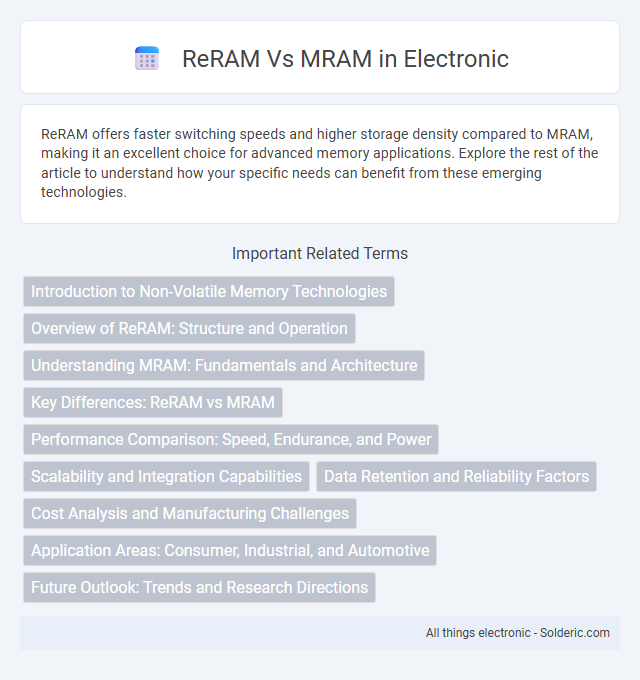ReRAM offers faster switching speeds and higher storage density compared to MRAM, making it an excellent choice for advanced memory applications. Explore the rest of the article to understand how your specific needs can benefit from these emerging technologies.
Comparison Table
| Feature | ReRAM (Resistive RAM) | MRAM (Magnetoresistive RAM) |
|---|---|---|
| Technology Type | Resistive switching memory | Magnetic tunnel junction-based memory |
| Data Storage Mechanism | Resistance changes via filament formation | Magnetization states of ferromagnetic layers |
| Speed | ~10-100 ns | ~10 ns (faster writes and reads) |
| Endurance | Up to 10^9 write cycles | Up to 10^15 write cycles |
| Data Retention | 10+ years at 85degC | 10+ years at 125degC |
| Power Consumption | Low write energy, low leakage | Very low write energy, near-zero leakage |
| Scalability | High, suitable for <10 nm nodes | Moderate, challenged below 20 nm |
| Non-volatility | Yes | Yes |
| Use Cases | Embedded memory, neuromorphic computing | Cache memory, instant-on systems |
Introduction to Non-Volatile Memory Technologies
ReRAM (Resistive Random Access Memory) and MRAM (Magnetoresistive Random Access Memory) are emerging non-volatile memory technologies that offer faster speeds and higher endurance compared to traditional flash memory. ReRAM operates by changing the resistance across a dielectric solid-state material, allowing data retention without power, while MRAM uses magnetic states to store information, enabling high-speed, low-power performance with exceptional durability. Both are pivotal for future computing applications demanding persistent memory with enhanced scalability and reliability.
Overview of ReRAM: Structure and Operation
Resistive Random-Access Memory (ReRAM) operates by changing the resistance across a dielectric solid-state material, typically metal oxides, through the formation and rupture of conductive filaments. Its structure consists of a simple metal-insulator-metal (MIM) sandwich, where switching occurs due to applied voltage causing redox reactions or ion migration within the insulator layer. This nanoscale switching mechanism enables ReRAM to achieve high speed, low power consumption, and excellent scalability compared to traditional memory technologies.
Understanding MRAM: Fundamentals and Architecture
MRAM (Magnetoresistive Random Access Memory) utilizes magnetic states to store data, offering non-volatile memory with high endurance and speed, unlike traditional charge-based memories like ReRAM. Its architecture is based on Magnetic Tunnel Junctions (MTJs), where data is represented by the relative orientation of magnetic layers, enabling fast read/write cycles and low power consumption. Understanding MRAM fundamentals helps you evaluate its advantages in applications requiring durability, speed, and scalability compared to ReRAM's resistive switching mechanism.
Key Differences: ReRAM vs MRAM
ReRAM (Resistive Random-Access Memory) relies on changing resistance in materials to store data, offering high-speed write and erase cycles with lower power consumption. MRAM (Magnetoresistive Random-Access Memory) uses magnetic states to represent data, providing non-volatility and excellent endurance with fast read speeds. Your choice between ReRAM and MRAM depends on the specific application requirements such as speed, endurance, power efficiency, and data retention.
Performance Comparison: Speed, Endurance, and Power
ReRAM offers faster write speeds compared to MRAM, enabling quicker data storage with latency often below 10 nanoseconds, while MRAM typically operates in the 10-50 nanoseconds range. In terms of endurance, MRAM excels with over 10^15 write cycles, far surpassing ReRAM's 10^12 cycles, making it ideal for intensive write applications. Power consumption favors ReRAM due to its lower write energy, often consuming less than 1 picojoule per bit, whereas MRAM requires higher power for magnetic switching operations.
Scalability and Integration Capabilities
ReRAM offers superior scalability due to its simple metal-insulator-metal structure, enabling fabrication at smaller technology nodes and high-density integration in 3D architectures. MRAM integration benefits from compatibility with standard CMOS processes, but its reliance on magnetic tunnel junctions limits scaling below 20nm compared to ReRAM. Both technologies support embedded memory applications, yet ReRAM's low power consumption and high endurance provide advantages for next-generation non-volatile memory scaling and system-on-chip integration.
Data Retention and Reliability Factors
ReRAM exhibits high data retention capabilities due to its resistance to physical wear and stable non-volatile memory cells, making it reliable for long-term storage applications. MRAM offers exceptional endurance and low error rates, with magnetic tunnel junctions that provide robust data retention even under extreme temperature variations. Both technologies depend on distinct mechanisms--ReRAM's resistive switching and MRAM's magnetic states--impacting their reliability and suitability across different memory-intensive environments.
Cost Analysis and Manufacturing Challenges
ReRAM (Resistive RAM) offers lower fabrication costs due to its simpler structure and compatibility with existing CMOS processes, but faces challenges in material variability and endurance reliability. MRAM (Magnetoresistive RAM) demands more complex manufacturing steps using magnetic tunnel junctions, leading to higher production costs but benefits from superior speed and non-volatility. The choice between ReRAM and MRAM depends on balancing cost-efficiency with performance requirements and scalability in advanced semiconductor fabrication.
Application Areas: Consumer, Industrial, and Automotive
ReRAM excels in high-density storage and low power consumption, making it ideal for consumer electronics such as smartphones and tablets. MRAM offers fast read/write speeds and high endurance, suited for industrial applications requiring real-time data processing and harsh environment reliability. In the automotive sector, MRAM's robustness and non-volatility ensure reliable performance in advanced driver-assistance systems (ADAS) and infotainment platforms, while ReRAM is increasingly explored for energy-efficient embedded memory applications.
Future Outlook: Trends and Research Directions
ReRAM and MRAM technologies are advancing rapidly, with ReRAM showing promise in high-density storage and neuromorphic computing due to its low power consumption and scalability. MRAM research emphasizes improving speed, endurance, and integration with CMOS processes to meet the demands of next-generation memory applications. Your choice between these memory types will increasingly depend on specific use cases such as non-volatile storage or fast, durable cache memory as both continue to evolve with enhanced materials and device architectures.
ReRAM vs MRAM Infographic

 solderic.com
solderic.com